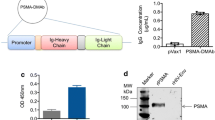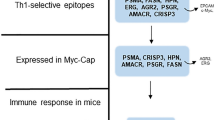Abstract
New gene expressed in prostate (NGEP) is a prostate-specific gene encoding either a small cytoplasmic protein (NGEP-S) or a larger polytopic membrane protein (NGEP-L). NGEP-L expression is detectable only in prostate cancer, benign prostatic hyperplasia and normal prostate. We have identified an HLA-A2 binding NGEP epitope (designated P703) which was used to generate T cell lines from several patients with localized and metastatic prostate cancer. These T cell lines were able to specifically lyse HLA-A2 and NGEP-expressing human tumor cells. NGEP-P703 tetramer binding assays demonstrated that metastatic prostate cancer patients had a higher frequency of NGEP-specific T cells when compared with healthy donors. Moreover, an increased frequency of NGEP-specific T cells was detected in the peripheral blood mononuclear cells of prostate cancer patients post-vaccination with a PSA-based vaccine, further indicating the immunogenicity of NGEP. These studies thus identify NGEP as a potential target for T cell-mediated immunotherapy of prostate cancer.



Similar content being viewed by others
Abbreviations
- APC:
-
Antigen-presenting cells
- CTL:
-
Cytotoxic T lymphocytes
- DC:
-
Dendritic cells
- EBV:
-
Epstein Barr virus
- EST:
-
Expressed sequence tag
- E:T:
-
Effector:target
- HLA-A2:
-
Human leukocyte antigen-A2 allele
- IFN:
-
Interferon
- IVS:
-
In vitro stimulation
- mAb:
-
Monoclonal antibody
- MFI:
-
Mean fluorescence intensity
- NGEP:
-
New gene expressed in prostate
- PBMC:
-
Peripheral blood mononuclear cells
- PE:
-
Phycoerythrin
- PSA:
-
Prostate-specific antigen
- TRICOM:
-
Triad of costimulatory molecules (B7.1, ICAM-1, LFA-3)
References
Jemal A, Siegel R, Ward E, Hao Y, Xu J, Murray T, Thun MJ (2008) Cancer statistics, 2008. CA Cancer J Clin 58:71–96
Karnes RJ, Whelan CM, Kwon ED (2006) Immunotherapy for prostate cancer. Curr Pharm Des 12:807–817
Arlen PM, Gulley JL, Parker C, Skarupa L, Pazdur M, Panicali D, Beetham P, Tsang KY, Grosenbach DW, Feldman J, Steinberg SM, Jones E, Chen C, Marte J, Schlom J, Dahut W (2006) A randomized phase II study of concurrent docetaxel plus vaccine versus vaccine alone in metastatic androgen-independent prostate cancer. Clin Cancer Res 12:1260–1269
Gulley JL, Arlen PM, Bastian A, Morin S, Marte J, Beetham P, Tsang KY, Yokokawa J, Hodge JW, Menard C, Camphausen K, Coleman CN, Sullivan F, Steinberg SM, Schlom J, Dahut W (2005) Combining a recombinant cancer vaccine with standard definitive radiotherapy in patients with localized prostate cancer. Clin Cancer Res 11:3353–3362
Schlom J, Gulley JL, Arlen PM (2007) Role of vaccine therapy in cancer: biology and practice. Curr Oncol 14:238–245
Harada M, Noguchi M, Itoh K (2003) Target molecules in specific immunotherapy against prostate cancer. Int J Clin Oncol 8:193–199
Arlen PM, Gulley JL, Tsang KY, Schlom J (2003) Strategies for the development of PSA-based vaccines for the treatment of advanced prostate cancer. Expert Rev Vaccines 2:483–493
Ghosh A, Heston WD (2004) Tumor target prostate specific membrane antigen (PSMA) and its regulation in prostate cancer. J Cell Biochem 91:528–539
Iavarone C, Wolfgang C, Kumar V, Duray P, Willingham M, Pastan I, Bera TK (2002) PAGE4 is a cytoplasmic protein that is expressed in normal prostate and in prostate cancers. Mol Cancer Ther 1:329–335
Jalkut MW, Reiter RE (2002) Role of prostate stem cell antigen in prostate cancer research. Curr Opin Urol 12:401–406
Kiessling A, Schmitz M, Stevanovic S, Weigle B, Holig K, Fussel M, Fussel S, Meye A, Wirth MP, Rieber EP (2002) Prostate stem cell antigen: Identification of immunogenic peptides and assessment of reactive CD8+ T cells in prostate cancer patients. Int J Cancer 102:390–397
Lilja H, Ulmert D, Vickers AJ (2008) Prostate-specific antigen and prostate cancer: prediction, detection and monitoring. Nat Rev Cancer 8(4):268–278
Peshwa MV, Shi JD, Ruegg C, Laus R, van Schooten WC (1998) Induction of prostate tumor-specific CD8+ cytotoxic T-lymphocytes in vitro using antigen-presenting cells pulsed with prostatic acid phosphatase peptide. Prostate 36:129–138
Slovin SF (2005) Targeting novel antigens for prostate cancer treatment: focus on prostate-specific membrane antigen. Expert Opin Ther Targets 9:561–570
Taira A, Merrick G, Wallner K, Dattoli M (2007) Reviving the acid phosphatase test for prostate cancer. Oncology (Williston Park) 21:1003–1010
Yokokawa J, Bera TK, Palena C, Cereda V, Remondo C, Gulley JL, Arlen PM, Pastan I, Schlom J, Tsang KY (2007) Identification of cytotoxic T-lymphocyte epitope(s) and its agonist epitope(s) of a novel target for vaccine therapy (PAGE4). Int J Cancer 121:595–605
Carter RE, Feldman AR, Coyle JT (1996) Prostate-specific membrane antigen is a hydrolase with substrate and pharmacologic characteristics of a neuropeptidase. Proc Natl Acad Sci USA 93:749–753
Reiter RE, Gu Z, Watabe T, Thomas G, Szigeti K, Davis E, Wahl M, Nisitani S, Yamashiro J, Le Beau MM, Loda M, Witte ON (1998) Prostate stem cell antigen: a cell surface marker overexpressed in prostate cancer. Proc Natl Acad Sci USA 95:1735–1740
Bera TK, Das S, Maeda H, Beers R, Wolfgang CD, Kumar V, Hahn Y, Lee B, Pastan I (2004) NGEP, a gene encoding a membrane protein detected only in prostate cancer and normal prostate. Proc Natl Acad Sci USA 101:3059–3064
Galindo BE, Vacquier VD (2005) Phylogeny of the TMEM16 protein family: some members are overexpressed in cancer. Int J Mol Med 16:919–924
Das S, Hahn Y, Nagata S, Willingham MC, Bera TK, Lee B, Pastan I (2007) NGEP, a prostate-specific plasma membrane protein that promotes the association of LNCaP cells. Cancer Res 67:1594–1601
Das S, Hahn Y, Walker DA, Nagata S, Willingham MC, Peehl DM, Bera TK, Lee B, Pastan I (2008) Topology of NGEP, a prostate-specific cell:cell junction protein widely expressed in many cancers of different grade level. Cancer Res 68:6306–6312
Housseau F, Langer DA, Oberholtzer SD, Moorthy A, Levitsky HI, Pardoll DM, Topalian SL (2002) Tumor-specific CD8+ T lymphocytes derived from the peripheral blood of prostate cancer patients by in vitro stimulation with autologous tumor cell lines. Int J Cancer 98:57–62
DeMars R, Rudersdorf R, Chang C, Petersen J, Strandtmann J, Korn N, Sidwell B, Orr HT (1985) Mutations that impair a posttranscriptional step in expression of HLA-A and -B antigens. Proc Natl Acad Sci USA 82:8183–8187
Hogan KT, Shimojo N, Walk SF, Engelhard VH, Maloy WL, Coligan JE, Biddison WE (1988) Mutations in the alpha 2 helix of HLA-A2 affect presentation but do not inhibit binding of influenza virus matrix peptide. J Exp Med 168:725–736
Britten CM, Meyer RG, Kreer T, Drexler I, Wolfel T, Herr W (2002) The use of HLA-A*0201-transfected K562 as standard antigen-presenting cells for CD8(+) T lymphocytes in IFN-gamma ELISPOT assays. J Immunol Methods 259:95–110
Parker KC, Bednarek MA, Coligan JE (1994) Scheme for ranking potential HLA-A2 binding peptides based on independent binding of individual peptide side-chains. J Immunol 152:163–175
Tsang KY, Palena C, Gulley J, Arlen P, Schlom J (2004) A human cytotoxic T-lymphocyte epitope and its agonist epitope from the nonvariable number of tandem repeat sequence of MUC-1. Clin Cancer Res 10:2139–2149
Nijman HW, Houbiers JG, Vierboom MP, van der Burg SH, Drijfhout JW, D’Amaro J, Kenemans P, Melief CJ, Kast WM (1993) Identification of peptide sequences that potentially trigger HLA-A2.1-restricted cytotoxic T lymphocytes. Eur J Immunol 23:1215–1219
Lattouf JB, Arlen PM, Pinto PA, Gulley JL (2006) A phase I feasibility study of an intraprostatic prostate-specific antigen-based vaccine in patients with prostate cancer with local failure after radiation therapy or clinical progression on androgen-deprivation therapy in the absence of local definitive therapy. Clin Genitourin Cancer 5:89–92
Tsang KY, Zaremba S, Nieroda CA, Zhu MZ, Hamilton JM, Schlom J (1995) Generation of human cytotoxic T cells specific for human carcinoembryonic antigen epitopes from patients immunized with recombinant vaccinia-CEA vaccine. J Natl Cancer Inst 87:982–990
Palena C, Schlom J, Tsang KY (2003) Differential gene expression profiles in a human T-cell line stimulated with a tumor-associated self-peptide versus an enhancer agonist peptide. Clin Cancer Res 9:1616–1627
Palena C, Arlen P, Zeytin H, Greiner JW, Schlom J, Tsang KY (2003) Enhanced expression of lymphotactin by CD8+ T cells is selectively induced by enhancer agonist peptides of tumor-associated antigens. Cytokine 24:128–142
Harada M, Matsueda S, Yao A, Noguchi M, Itoh K (2005) Vaccination of cytotoxic T lymphocyte-directed peptides elicited and spread humoral and Th1-type immune responses to prostate-specific antigen protein in a prostate cancer patient. J Immunother 28:368–375
Acknowledgments
The authors thank Bonnie Casey and Debra Weingarten for their editorial assistance in the preparation of this manuscript. This research was supported by the Intramural Research Program of the Center for Cancer Research, NCI, NIH.
Conflict of interest statement
There are no potential conflicts of interest.
Author information
Authors and Affiliations
Corresponding author
Rights and permissions
About this article
Cite this article
Cereda, V., Poole, D.J., Palena, C. et al. New gene expressed in prostate: a potential target for T cell-mediated prostate cancer immunotherapy. Cancer Immunol Immunother 59, 63–71 (2010). https://doi.org/10.1007/s00262-009-0723-6
Received:
Accepted:
Published:
Issue Date:
DOI: https://doi.org/10.1007/s00262-009-0723-6




